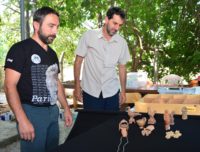 Archaeologists have unearthed childrens’ toys in 2,000-year-old tombs in the ancient Greek city of Parion, located in the modern-day village of Kemer, in northwestern Turkey’s Çanakkale province. The small figurines were made of clay and are identifiable as grave goods for children because they were buried with them in small wooden coffins.
Archaeologists have unearthed childrens’ toys in 2,000-year-old tombs in the ancient Greek city of Parion, located in the modern-day village of Kemer, in northwestern Turkey’s Çanakkale province. The small figurines were made of clay and are identifiable as grave goods for children because they were buried with them in small wooden coffins.
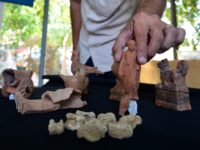 Parion, or Parium, was founded in 709 B.C. by Greek colonists, possibly from Eretria, the city in Euboea that just came up a couple of days ago in conjuction with the discovery of the Artemis sanctuary. In the 5th century B.C. Parion joined the Delian League, an association led by Athens ostensibly to unite in military defense against future Persian invasions but which Athens soon diverted to its own ends. The tensions that resulted between the Greek city-states by the end of the century led to the Peloponnesian War and the dissolution of the league.
Parion, or Parium, was founded in 709 B.C. by Greek colonists, possibly from Eretria, the city in Euboea that just came up a couple of days ago in conjuction with the discovery of the Artemis sanctuary. In the 5th century B.C. Parion joined the Delian League, an association led by Athens ostensibly to unite in military defense against future Persian invasions but which Athens soon diverted to its own ends. The tensions that resulted between the Greek city-states by the end of the century led to the Peloponnesian War and the dissolution of the league.
At the time when the tombs were built, Parion was a Roman colony in its Asia province. It was a prosperous hub of the Aegean trade with two major harbours through which all goods bounds for what is today Istanbul passed.
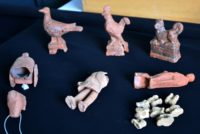 Archaeologists have been excavating the site, including necropoli from various periods, since 2005. The necropolis from the Roman period includes burials of both adults and children. The children were buried in their own individual caskets, toys placed lovingly around their bodies. Some of them might have been favorite toys used during their lifetime. Others were a kind of posthumous present to send the child to the afterworld with plenty of things to play with. Others — symbolic animal figurines, deities, mythological creatures — had a religious function, to help the deceased with all their ritual needs to ensure a smooth transition to the other side.
Archaeologists have been excavating the site, including necropoli from various periods, since 2005. The necropolis from the Roman period includes burials of both adults and children. The children were buried in their own individual caskets, toys placed lovingly around their bodies. Some of them might have been favorite toys used during their lifetime. Others were a kind of posthumous present to send the child to the afterworld with plenty of things to play with. Others — symbolic animal figurines, deities, mythological creatures — had a religious function, to help the deceased with all their ritual needs to ensure a smooth transition to the other side.
Researchers have discovered toys and other articles during excavations at the ancient site, Professor Hasan Kasaoğlu from Atatürk University, who is the excavation leader at Parion, told the Anadolu Agency.
He noted that the toys were presented as “gifts for the dead” children and provide significant information about the sociocultural structure of the period.
For instance, Kasaoğlu highlighted that female figurines were found in tombs belonging to girls, while male figures were found in tombs belonging to boys.
“2,000 years ago girls played with ‘Barbie-like’ dolls, the same way they do now,” Kasaoğlu said, adding that although objects have changed shapes and features, humans have always had the same mentality.
That’s debatable, as this photograph captures rather succinctly:
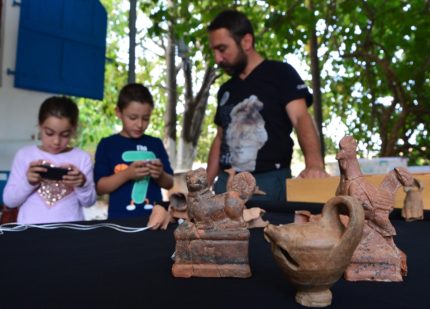
Other child-sized artifacts have been recovered from the Roman necropolis at Parion. Less than a month ago the team unearthed a tiny earthenware vessel used to feed infants, the ancient version of the baby bottle which looks like a miniature teapot, complete with a wee handle and spout.
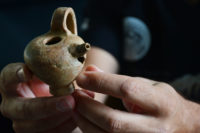
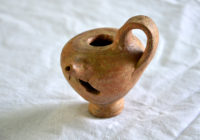
I wonder who the headless figure was supposed to be?
And then there is the horse’s head. Is that to scare the child when the wake up in the Afterworld?
😉
Oh my goodness, it’s sad that those kids are looking at their phones when those toys are right there on the table. I’ve loved archeology since I was very young; I would have been all over those if I’d been given a chance!
That’s a set of knucklebones, isn’t it, that keeps popping up in the photos?
“The signature PLAYMOBIL toy is a 7.5 cm (~ 3 inches) tall human figure with a particular cherub-like smiling face” :thanks:
————–
… and there even are the “knucklebones” that Ed is referring to. 😆
To conclude, the signature Parion toy (2nd picture) is roughly the same, but made from clay.